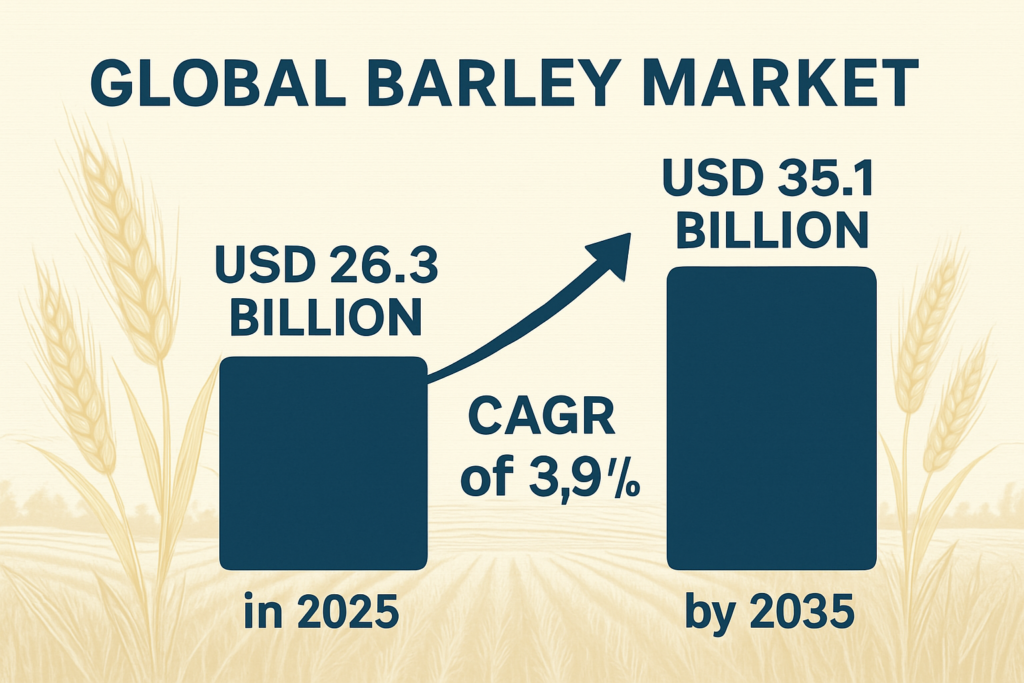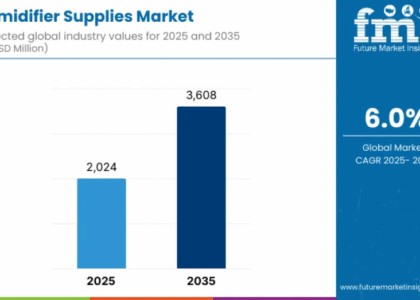
The global barley market, valued at USD 26.3 billion in 2025, is expected to reach USD 35.1 billion by 2035, growing at a steady CAGR of 3.9%. As a fiber-rich, climate-resilient, and nutritionally balanced cereal, barley continues to solidify its importance across food, beverage, and animal feed sectors. The rise of craft brewing, functional foods, and sustainable agriculture practices are key forces driving this growth globally.
Unveil Market Trends: Get Your Sample Report Now: https://www.futuremarketinsights.com/reports/sample/rep-gb-1273
Market Trends Highlighted:
Rising Demand for Feed-Grade Barley: Feed-grade barley is projected to account for 42.3% of the total market share in 2025, driven by growth in livestock and animal husbandry industries. Its digestibility and energy-to-protein ratio make it a preferred grain in animal feed formulations.
Brewing Sector Expansion: The global rise in consumption of premium, craft, and non-alcoholic beers is amplifying demand for high-quality malted barley. This trend is prominent across the USA, UK, Canada, and India.
Functional Food Applications on the Rise: With increasing consumer focus on health and wellness, barley-based products such as high-fiber cereals, plant protein alternatives, and barley teas are gaining traction.
Adoption of Sustainable and Smart Agriculture: Countries are investing in climate-resilient barley varieties and precision agriculture, including AI-powered monitoring, regenerative practices, and green irrigation systems.
Increased Market Insight Demand: Get Thorough Analysis and Trends in Our Complete Report: https://www.futuremarketinsights.com/reports/barley-market
Key Takeaways of the Report:
- Market Size and Forecast: The global barley market is anticipated to grow from USD 26.3 billion in 2025 to USD 35.1 billion by 2035, expanding at a CAGR of 3.9%.
- Feed-Grade Barley Dominance: Feed applications will lead the market, with 42.3% market share in 2025, reflecting ongoing demand from the livestock sector.
- Growth Hotspots Identified: India (5.1% CAGR), the USA (4.8%), and the UK (4.5%) are among the fastest-growing markets, attributed to innovation in food and beverage sectors and supportive government policies.
- Functional Food Momentum: The rise of barley-based wellness foods is reinforcing its relevance beyond traditional brewing and feed uses.
Regional Market Outlook:
USA:
The U.S. barley market is thriving due to robust demand from the craft beer industry and health-conscious consumers seeking non-alcoholic malt beverages. Key production regions like North Dakota and Idaho are adopting climate-resilient strains and regenerative practices, contributing to a projected CAGR of 4.8%.
Canada:
Canada is leveraging its thriving craft brewing industry and rising functional food consumption to boost barley demand. With increasing integration of agritech like AI-based monitoring and green irrigation, the market is projected to grow at a 4.2% CAGR.
UK:
Renowned for its beer and whiskey industries, the UK market is sustained by rising exports, craft brewing, and government incentives for carbon-neutral farming. The market is expected to grow at a 4.5% CAGR.
India:
India is the fastest-growing barley market, at a 5.1% CAGR. Demand is rising from the brewing sector and health food manufacturers. Farmers are increasingly adopting drought-resistant varieties and benefiting from policies promoting sustainable farming.
Japan:
Japan’s barley market remains steady with a 3.9% CAGR. Demand is supported by premium beer and functional foods like barley tea. Most barley is imported, but domestic production focuses on organic and specialty types.
Competition Outlook:
The global barley market is moderately consolidated, with strong regional competition and increasing specialization. Key players are focusing on improving crop yields, processing efficiency, and supply chain sustainability. Demand is increasingly niche-oriented, driven by preferences for craft-grade, high-malt barley and health-oriented variants. Major barley-producing nations like the U.S., Canada, and Australia are competing to supply to high-demand importers such as Japan and parts of Asia.
Strategic Developments:
- Producers are investing in drought-resistant and high-yielding barley varieties to combat climate volatility.
- Breweries and food companies are collaborating with farmers to secure high-quality local barley through contract farming.
- Barley suppliers are emphasizing traceability, organic certifications, and low-carbon production to meet evolving consumer and regulatory standards.
Key Industry Players
- Tyson Foods Inc.
- JBS S.A.
- WH Group (Smithfield Foods)
- Cargill Inc.
- Hormel Foods Corporation
- BRF S.A.
- Pilgrim’s Pride Corporation
- Maple Leaf Foods Inc.
- Nippon Meat Packers Inc.
- Danish Crown Group
Explore Grains, Pulses & Legumes Industry Analysis: https://www.futuremarketinsights.com/industry-analysis/grains-pulses-and-legumes
Key Segmentation
By Application:
By application, the industry is segmented into alcoholic beverages, non-alcoholic beverages, personal care products, animal feed, food, and pharmaceuticals (supplements).
By Grade:
By grade, the industry is segmented into malt grade, standard, food grade, specialty, pharmaceutical grade, cosmetic grade, and feed grade.
By Product Type:
By product type, the industry is segmented into barley flour, pearl barley, barley grits, barley malt, barley flakes, and whole grain barley.
By Region:
By region, the industry is segmented into North America, Latin America, Europe, Asia Pacific, and the Middle East & Africa.





